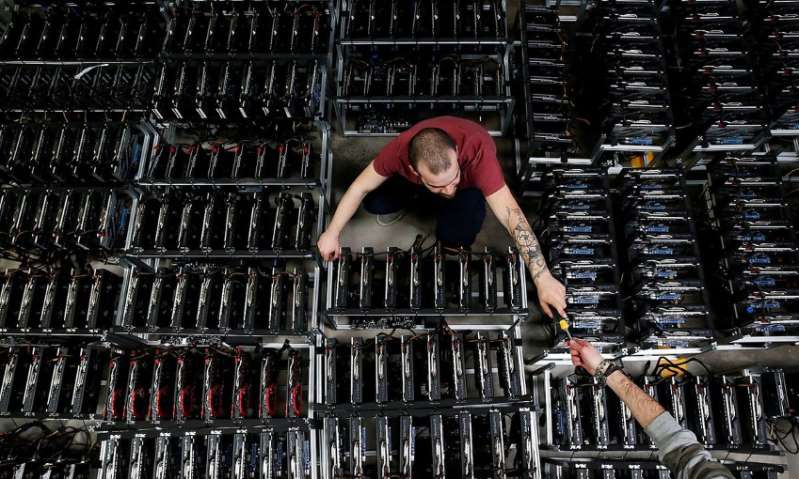
The market for crypto assets appears to have been unleashed. Since PayPal announced last fall that it would open its platform to Bitcoin and other digital “currencies”, their prices have multiplied. A unit of Bitcoin, the most famous cryptocurrency, cost around $ 13,900 at the end of October 2020, compared to over $ 58,000 on February 21 of this year. In between there were, among other things, the announcement by Tesla boss Elon Musk that he wanted to invest 1.5 billion dollars in Bitcoin, unmistakable signals from central banks to keep interest rates at their historic lows, and in many countries rising government spending to cushion the economic effects of the pandemic , or various short squeezes triggered by small investors via social media. These and other reasons prompted many investors to make large-scale investments in crypto assets.
In this market environment, the greatest concern of many market participants seems to be missing out on potential profits as a result of rapidly rising prices by waiting too long. This “fear of missing out (FOMO)” means that investment decisions are no longer made on the basis of rational considerations, but solely on the basis of emotions, in which risk aspects are neglected in favor of expected returns. If this effect occurs on a large scale, it leads to the formation of bubbles with well-known consequences.
The recent price developments, which seem unsustainable, conceal the actual innovation potential that lies behind crypto assets – and which (the author's hypothesis) is likely to be little known in detail to a large number of investors who are currently speculating wildly on the crypto market. Essentially, it consists in transferring values (e.g. in the form of money, but also property rights or contracts mapped in smart contracts) via a digital network without central authorities and thereby building trust in an institution (e.g. a (note ) Bank) by the consensus of the network participants.
The innovative technology behind this system is the blockchain, which, as a publicly accessible register, saves all network transactions in standardized form in individual blocks and links them with existing blocks. The decentralized mechanism of the Bitcoin system enables each participating network node not only to view the register, but also to expand it to include new transactions, for which purpose the solution of a computationally intensive, cryptographic puzzle is provided in the Bitcoin system. The node that is able to solve this first receives new virtual monetary units (the actual bitcoins), which are managed as 64-digit hexadecimal code in a “wallet”, an electronic purse.
What has recently been paid on the market for Bitcoin prices of $ 50,000 and more are essentially virtual strings that miners can credit themselves as payment for verifying transactions in blocks and that function as monetary units in the system. Just like the euro or USD, Bitcoin represents fiat money without a fundamental value, but behind which there is no issuer with a legal mandate. For this reason, virtual coins only fulfill the functions of money to a limited extent. Use and acceptance as a medium of exchange – albeit increasing – are still very limited. In addition, the Bitcoin network, for example, only allows a limited number of transactions to be carried out in real time and the transaction costs are sometimes considerable. Strong price fluctuations – and they existed before autumn 2020 – also make it unlikely to be used as a widespread accounting unit or as a means of storing value.
The absolute amount of Bitcoins (maximum 21 million units) specified in the protocol also tends to lead to higher volatility, because fluctuations in demand cannot be balanced out accordingly. Bitcoin as an alternative to gold in the sense of a “safe haven” therefore appears questionable. Finally, a point not to be neglected is the substitutability of individual cryptocurrencies. For example, after the Bitcoin system is completely transparent, it can be replaced at any time by a similar, technologically improved system.
Lessons from the dot-com hype
But where do so many investors get the hope of getting rich by investing in Bitcoin or other speculative crypto assets? Following Keynes, it is above all the expectations about the expectations of the other market participants. As long as you anticipate the FOMO effect and assume that more investors will pour into the market, the price increase will continue. Lessons from this stock market psychology – especially in connection with potentially disruptive technologies – can be drawn from the dot-com hype of the turn of the millennium. The spread of the Internet led to a sharp rise in the stock market prices of IT companies that only had to give the appearance of being connected to the development or use of the Internet. The bursting of the bubble not only made many of these companies disappear from investors' lists. The stock market crash, however, did not affect internet technology, and with Google and Amazon, two “survivors” of the dotcom bubble are among the largest companies in the world.
Parallels to the current crypto hype emerge. The price rally for crypto assets will probably come to an abrupt end, and a large part will disappear from the market. Blockchain technology, on the other hand, will expand its range of possible applications in both monetary and non-monetary areas (e.g. in the digital networking of smart objects, in supply chain management, or the provision, checking and preservation of guarantees of origin) and generate efficiency gains. One indication of this is the fact that numerous central banks (including the ECB and Fed) are intensively involved in developing their own digital currencies. If these are part of a stability-oriented monetary policy, the use of Bitcoin, Ethereum and Co. as means of payment in the future will remain marginal.

